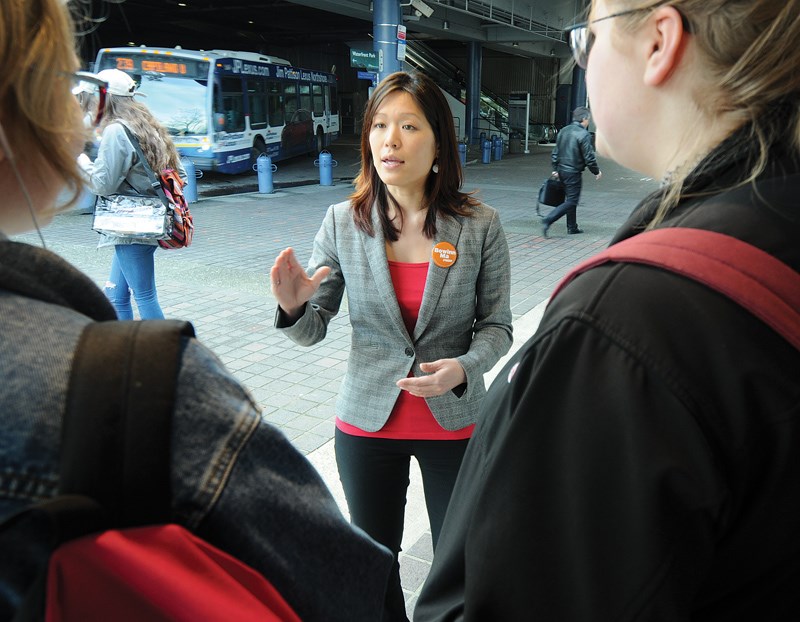Editor's note: This story has been edited
Regardless of who forms government after May 9, District of North Vancouver Mayor Richard Walton has a wish list: Better transportation and better transportation.
“We have this two-tier system where transit is subject to referenda, and yet highway expansion and bridges aren’t – and they’re both key and complementary parts to the regional transportation system,” he said.
With pretty much daily traffic jams on Highway 1 and its feeder routes, the Lions Gate Bridge, and full buses at rush hour, candidates from the three major parties are eager to boast about their transportation plans.
The NDP is prioritizing public transit expansion in their platform, said North Vancouver-Lonsdale candidate, Bowinn Ma, a SeaBus commuter and an engineer who studied transportation systems.
“We know that traffic on the North Shore sucks. It really does. The B.C. Liberal Party have basically been taking the North Shore voters for granted,” Ma said.
The party is pledging to fund 40 per cent of the Mayors’ Council on Regional Transportation’s 10-year plan, which would bring more transit service to the North Shore, including SeaBus as well as regular and B-Line buses connecting the North Shore to downtown.
With the federal Liberals including another 40 per cent in their budget, that leaves the remaining 20 per cent from the mayors, which won’t be subject to a referendum or plebiscite like the one the Liberals held in 2015, Ma said.
“They dragged the Lower Mainland through a referendum that was designed to fail, and I simply don’t trust them anymore to make public transit spending a priority,” she said. “Suffice to say, with a provincial partner that values public transit investments, the mayors’ council and the municipalities can rest assured that we will work with them on how to complete that last 20 per cent,” she said.
Their platform also includes reforming TransLink’s governance model and working with the mayors to come up with a regional congestion strategy, Ma said.
North Vancouver-Seymour Liberal incumbent Jane Thornthwaite pointed to her government’s ushering in of projects that will revamp the interchanges at the bottom of the Cut, and add more lanes to the Lynn Creek Bridge.
“I’m in it every day going both ways. And everyone else is to. It’s absolutely the No. 1 issue, with the congestion at the bottom of the Cut,” she said.
Combined, that project is $198 million, about 70 per cent of which is coming from the province.
“I feel quite proud I was able to get all these three levels of government together and agree on the plan. Is the plan perfect? No. But it is definitely going to alleviate the majority of the problems that North Vancouverites have getting back and forth to where they need to go within the region.”
After spending much of the last term insisting they would not go above one-third funding for transit projects, the Liberals are also promising to match the $2.2 billion or 40 per cent the federal government included in its budget.
But Thornthwaite couldn’t offer any commitment on whether her government would support the mayors’ plans to come up with their 20 per cent.
“I am definitely interested to see what the mayors come up with. I have good respect for people like Richard Walton and his ideas,” she said.
Thornthwaite also reiterated her party’s promise to clear the way for ride-hailing apps like Uber to be operating in B.C. by the end of the year, which she said is in high demand from young people. Her party’s platform also includes “examin(ing) the possibility” of commuter rail on the Sea to Sky corridor.
The B.C. Green Party is also looking to woo voters with transit and “a resolute commitment to giving more people options to get around,” said West Vancouver-Capilano candidate and Capilano University instructor Michael Markwick.
Markwick said commuting to work by bus takes him 90 minutes from his home in Dundarave. “Our students are spending more time in transit than they are in classrooms,” he said.
The Greens’ platform commits an additional $25 million per year of funding for public transit “to address frequency of service and affordable fares” and an additional $152 million in capital to fully match the federal contribution of $460 million for public transit infrastructure.
“The mass transit piece isn’t working. We spend, out of West Vancouver, $15 million in TransLink levies out of our property taxes but we’re not seeing any kind of meaningful, 21st century upgrades,” he said.
The platform also promises mobility pricing for drivers to manage demand on the roads and to fund green transportation infrastructure.
Markwick said the provincial government should work more collaboratively and “should not be in the business of telling municipalities what is good for them.”
“That includes things like digging up the Massey Tunnel and replacing it with a bridge, and the $4 to $5 billion that will cost. I consider that to be an abuse of the province’s power,” he said. “Instead, what we need to do is work with municipal governments so that the people closest to the problems can fix them.”



